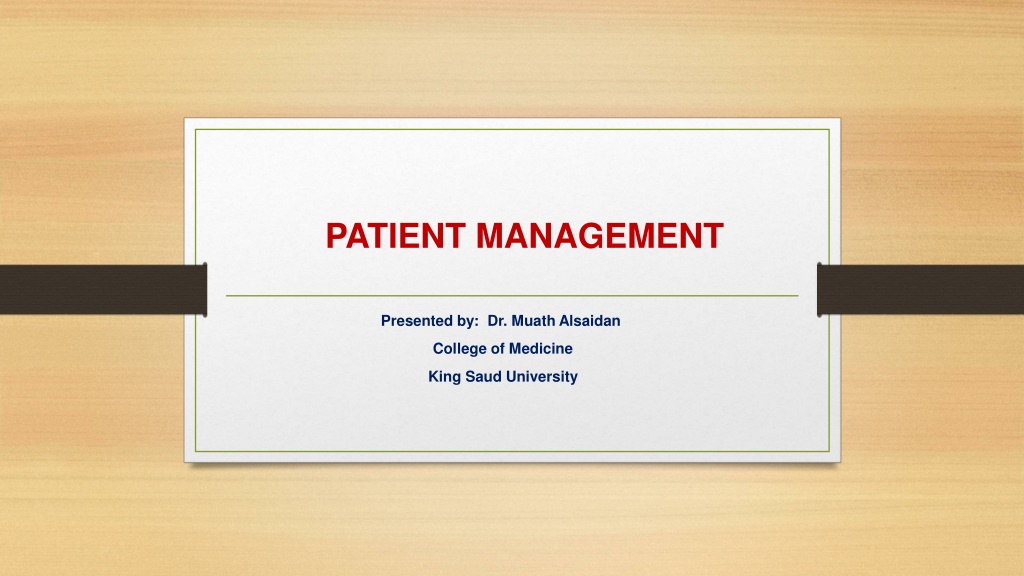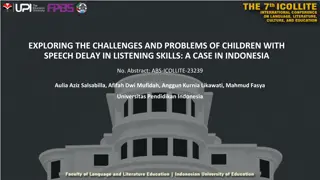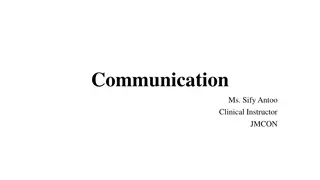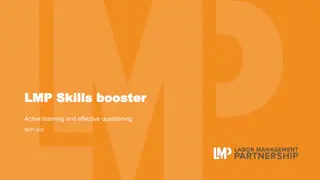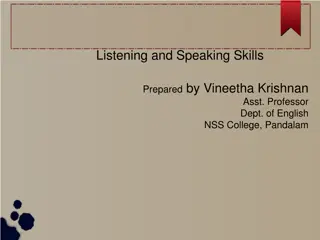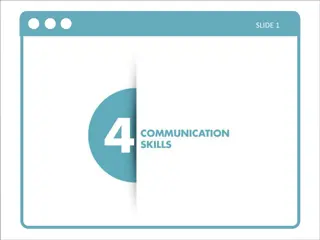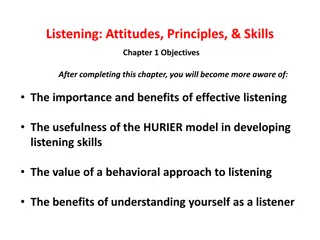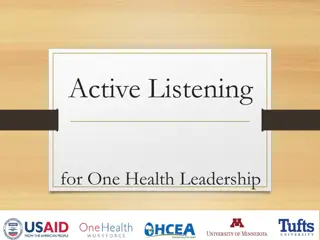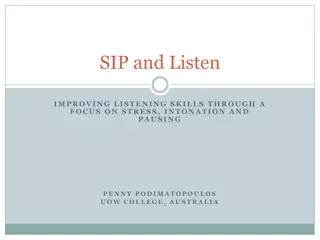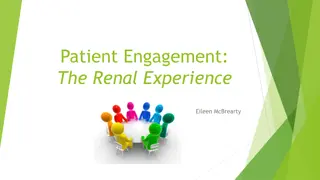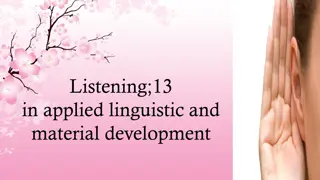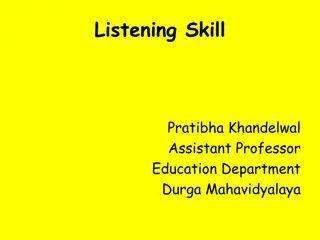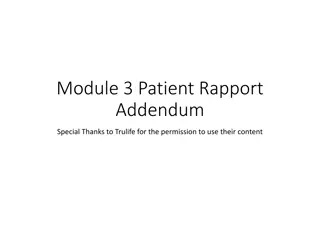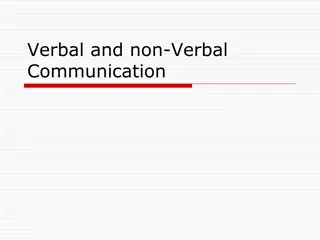Patient Management Strategies and Listening Techniques in Clinical Practice
This content highlights the essential aspects of patient management in a clinical setting, focusing on recognizing patient perceptions, implementing effective communication, choosing appropriate investigations, and emphasizing health promotion and disease prevention. It also discusses the importance of listening to patients attentively, understanding their feelings, fears, and expectations, and providing reassurance and explanations in a timely manner. The role of the family physician as a gatekeeper between primary and secondary care is also emphasized.
Download Presentation

Please find below an Image/Link to download the presentation.
The content on the website is provided AS IS for your information and personal use only. It may not be sold, licensed, or shared on other websites without obtaining consent from the author. Download presentation by click this link. If you encounter any issues during the download, it is possible that the publisher has removed the file from their server.
E N D
Presentation Transcript
PATIENT MANAGEMENT Presented by: Dr. Muath Alsaidan College of Medicine King Saud University
OBJECTIVES At the end of the session, the student should be able to: Recognize management of patient under the following headings; reassurance, advice, prescription, referral, investigation, follow-up and prevention. Identify patient s perception of the problem with implementation of communication and trust. Recognize investigations to be in terms of their cost-benefit and risks, and to be requested when helping diagnosis and management. Relate health promotion and disease prevention in patient management.
PATIENT MANAGEMENT Management should be considered under the following broad headings: Reassurance and/or Explanation Prescription Referral Investigation Observation Prevention The Family physician role as Gatekeeper between primary and secondary care
LISTENING At the beginning of an interview, the physician should try, by every means possible, to encourage the patient to tell his/her own story in his/her own way. Listening to the patient with undivided attention is a very difficult discipline. It requires intense concentration on everything the patient is trying to say, both verbally and nonverbally.
LISTENING Doctors, often, are not good listeners. We frequently interrupt. In one study, the average interval between the patient beginning to tell his story and the doctor interrupting was 18 seconds (Beckman and Frankel, 1984). A more recent study (Marvel, Epstein, Flowers, and Beckman, 1999) suggests that the situation may have slightly improved, with first interruption occurring after 23.1 seconds.
HISTORY Understanding the patient s feelings, fears, ideas, expectations, and the impact of the illness on his or her daily functioning is specific for each patient. The patient-centered clinical method, like the conventional method, gives the clinician a number of injunctions. Ascertain the patient s expectations recognizes the importance of knowing why the patient has come. Understand and respond to the patient s feelings acknowledges the crucial importance of the emotions. Make or exclude a clinical diagnosis recognizes the continuing power of correct classification.
REASSURANCE and/or EXPLANATION The need for reassurance may be the main reason for the patient presenting to the doctor, and management may and often does consist solely of this. (Michael Balint; 1986) The patient is often relieved by our true reassurance and afterwards the things will go in a favourable direction. Inappropriate reassurance can be a positive danger to the patient and can damage the doctor patient relationship. Premature reassurance is ineffective and may be interpreted by the patient as a rejection. The patient must be convinced that the physician has obtained the information necessary for reassurance.
REASSURANCE and/or EXPLANATION Certain symptoms and/or signs are strongly suggestive of a specific disease, e.g. chest pain, high blood pressure, headache, palpable mass, . Unless the doctor explores the patients understanding of their symptoms and their possible significance, it will not be possible to reassure them adequately. Communication and trust are two other factors that influence the success of reassurance as a management technique.
REASSURANCE and/or EXPLANATION First influential factor: Communication First explain the problem in terms that the patient can understand taking inconsideration; education, medical background, social class, personality, Second influential factor: Trust Reassurance carries more weight if there is a strong bond between the doctor and the patient
CASE HISTORY A 42-year-old man referred from blood bank as he is not candidate for blood transfusion as his Hb 12.7 gm/dl (Normal:13 18). He is totally asymptomatic Non smoker No H/O drugs FH: unremarkable
CASE HISTORY A 59-year-old man known case of DM on diet and hypothyroidism on thyroxin presents with swelling of left Lower Limb for one week and he claimed that he fell down from a height near 2 meters by jumping. He came to his doctor who used to see him in all visits. BP 136/72 Pulse 76 bpm BMI 20.4 O/E: the limb was swollen calf and thigh and different from other limb reaching 2.5 3 cm. Looks pale CVS: S1, S2 and 0 Chest: vesicular and no added sounds Abdomen: no tenderness, lax and no organomegally
COUNSELLING Sometimes reassurance, advice and explanation are insufficient, and the doctor may be required to assume a more formal counselling role to help patients work through or come to terms with their problems. Counselling has been defined as the various techniques and methods by which people can be helped to understand themselves and to be more effective (Munro et al., 1988).
COUNSELLING The fundamental aim of counselling is to assist patients to identify and implement their own unique solutions to a particular problem. This will open courses of action from which they can make a choice. Many doctors prefer to refer their patients to psychiatrist, psychologist or social worker to deal with such situations.
PRESCRIPTION First you have to minimize the occurrence of unwanted drug interactions between prescribed and self-administered drugs, by checking patient medication. The decision whether to prescribe or not in a consultation is critical. What are the clinical aims of prescribing?
PRESCRIPTION A. Therapeutic? Symptomatic: NSAIDs in OA or Back pain Curative: Antibiotic for bacterial infection Preventive: Prophylactic use of antibiotics, Aspirin in MI
PRESCRIPTION B. Tactical? To gain time when collecting more information e.g. antacid until endoscopy. To maintain contact with the patient e.g. to initiate an antihypertensive in asymptomatic patient. A trial of treatment e.g beta agonist for patient with cough and no wheezes, antibiotic in a patient with swelling of LN and still not diagnosed. To prescribe antibiotic e.g. URTI (could be bacterial or viral) to relieve doctor s anxiety and satisfy patient.
PRESCRIPTION You have to consider the following in Prescription: Indications and contraindication to its use. Appropriate doses regarding Age, Weight, Drug instructions. State of patients; pregnancy, lactation, comorbidity like renal or liver problems. Instructions given to patient. Compliance.
REFERRAL Referral Rate is varied according to many situations: Practice size. Qualification and experience of family physicians. Location. Access to diagnostic services. Ability of Family Physician to tolerate uncertainty. Attitude to illness. Value of hospital care. Relationship with hospital colleagues.
REFERRAL Referral of patients to secondary care has a number of reasons: To obtain specialist treatment To obtain a specialist opinion on diagnosis and/or management of a difficult problem. To gain access to certain diagnostic and therapeutic facilities that not available to Family Physicians. To relieve patients or relatives anxiety or pressure To provide reinforcement of advice given to a poorly-compliant patient.
Case A 58-year-old man, known case of diabetes, presents to clinic for follow up and claimed to have chest pain when climbing stairs of two flights which is relieved within few minutes by rest. His ECG is within normal. How are you going to manage him?
What should be included in the appropriate referral? History of patient: Complaint. Clinical findings. Provisional or Final diagnosis. Significant results. Medication. Reason of referral.
OUTPATIENT ATTNDENCES Multiple outpatient appointments can be confusing to patients, especially if they see different doctors on each occasion. Those who re-attending clinics tend to be seen by the more junior hospital doctors, who commonly rotate. Misunderstanding about diagnosis, prognosis and treatment can easily arise.
OUTPATIENT ATTNDENCES The more individuals involved in the care of the patient, the greater the potential for confusion and conflicting advice. The concepts of whole person medicine and continuity of care are of particular relevance in those patients who have frequent or varied contact with hospital services.
INVESTIGATIONS Why performed? To make or confirm a suspected diagnosis (e.g. thyroid in a patient with tendency to sleep). To exclude an unlikely but important and treatable diagnosis (to R/O Celiac disease in a patient with diarrhea / IBS.
INVESTIGATIONS Why performed? To monitor the effects or side effects of medicine (Lipid and LFT in Patient on Isotretinoin or B12 in patient on long treatment with Metformin). To screen asymptomatic patients (e.g. mammography for breast cancer). To reassure an anxious patient that nothing is seriously wrong.
INVESTIGATIONS The decision to investigate a patient, as with the decision to refer, is based on clinical judgment. Case History: A 48-year-old man asymptomatic, diagnosed incidentally in International Diabetes Day to have high blood sugar of 268 mg/dl and came to you in clinic. Which investigations are you going to request after history taking and examination?
INVESTIGATIONS If a doctor is still in considerable doubt about the diagnosis after taking history and examining the patient, it is unlikely that laboratory investigations will be very helpful. Sandler (1979), in a study of 630 hospital medical patients, found that routine CBC, ESR, U & E and Urine analysis in the absence of any clinical indication were of minimal value, contributing to only 1% of all diagnosis. Conclusion that investigations should answer the specific clinical questions.
INVESTIGATIONS The studies emphasized the considerable cost of indiscriminate investigation, and stressed the over-riding importance of a good clinical history. Reduction in request of investigation and cost could be by ongoing policy of intervention, including guidelines, seminars and experience. The inappropriateness of routine investigations is probably even greater in general practice since most patients suffer from non-life threatening and of self-limiting conditions.
INVESTIGATIONS So before requesting investigations you have to consider: Taking a more focused clinical history and ask: Why am I ordering this test? What am I going to look for in the result? If I find it, will it affect diagnosis? How will this affect my management of the case? Will this ultimately benefit the patient?
OBSERVATION Follow up is an essential part in patient management. For many problems, reassurance, explanation and follow-up are the only parts of management which are necessary. For minor, self limiting conditions (near 50% of consultations), such as URTI and dyspepsia, no formal follow-up is required except if there is a dramatic change in patient condition.
OBSERVATION Follow-up is necessary for chronic conditions like DM, HTN, Asthma.. . Acute and life threatening conditions like MI need follow-up after discharge.
PREVENTION Prevention, care and cure are all part of anticipatory care, which include both health promotion and disease prevention. Prevention should always be part of patient management plan as in appropriate e.g. way & how to lift and what should be avoided in LBP. The preventive opportunities not related to the presenting complain(s) e.g. check BP in a patient with OA, asking for H/O smoking and give advice, check vaccination state of a child coming for URTI etc.
PREVENTION Case History: A 58-year-old man came to clinic because of being diagnosed as having high blood pressure. BP 174/112 BMI 38 What areas of prevention are you going to tackle with this patient?
CONCLUSION Reassurance and/or Explanation: Must be specific and related to the patient s perception of the problem with implementation of communication and trust. Advice: Tailored to the personality and state of patient. Prescription: Aims of prescribing can be therapeutic, tactical or both.
CONCLUSION Referral: Whenever a referral is made, the family physician should act as a reference point, coordinator and source of explanation for the patient Investigation: Investigations should be considered in terms of their cost-benefit and risks, and should be requested when helping diagnosis and management.
CONCLUSION Observation: A doctor should monitor the progress of patient especially in chronic problems and life threatening conditions. Prevention: Involves health promotion and disease prevention to reduce premature death and disability.
Reference Clinical methods: A General Practice Approach Robin Fraser. Third Edition
